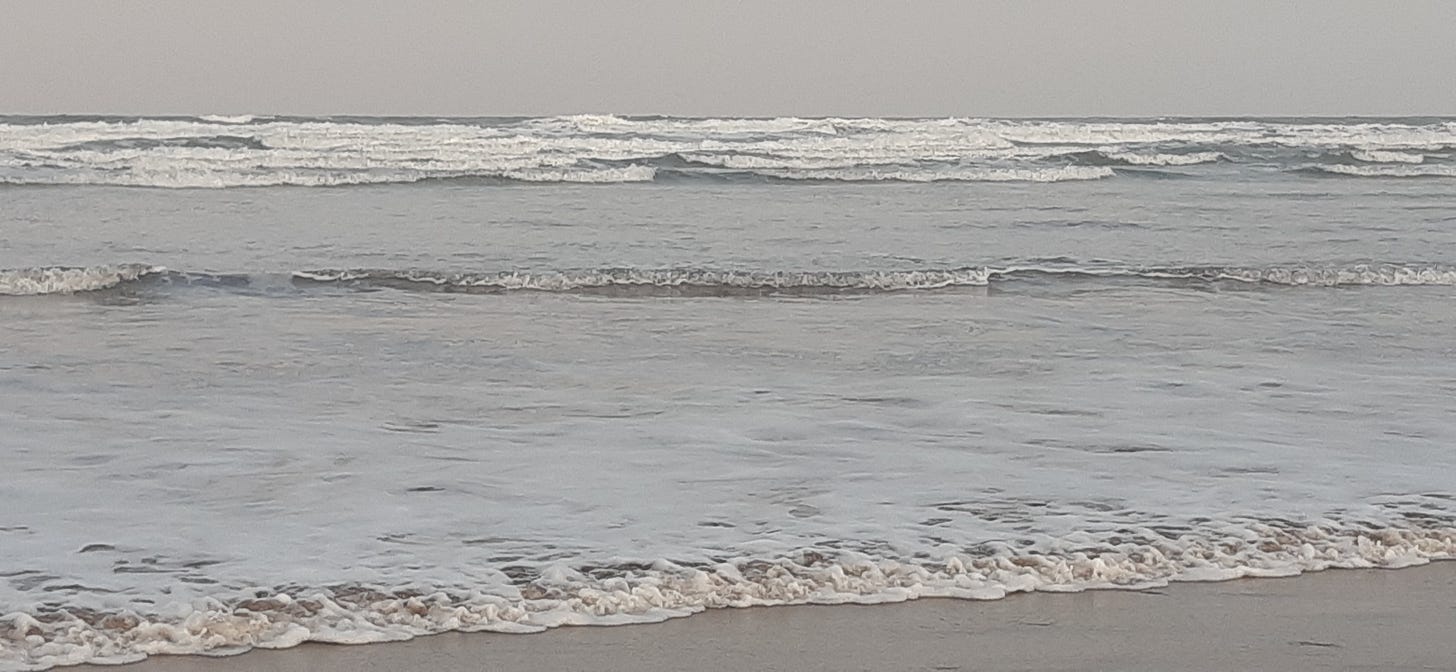How I started a writing habit
tl;dr - turns out you just write stuff then publish it
I’ve been on here for a few months now. I have almost no followers and subscribers, and my Notes attract very few comments and engagement. But I’ve now published three articles a week for twelve weeks, alongside daily posts on LinkedIn and X, and have established an actual writing habit.
I see a lot of articles about how to stop procrastinating and start writing, how to beat the fear, stop worrying and so on. I’m not sure how big this potential audience is of terrified, aspiring but not-yet writers – the sheer number of articles seems to imply that there are a lot of people in that position.
So in case that’s you, I thought I would write about how I got started writing on Substack. If you are that nervous, ambitious Substack lurker, do read on.
I had never heard of Substack until May this year. I am not any kind of established writer. I have always written, either for work or for my own entertainment, and I’ve always felt that it’s something I could probably do well if I put the time and effort in; I just hadn’t done that consistently until recently.
I realised many years ago that I needed to always have a creative side-project in my life. And my approach to Substack was based on three things I understand about myself – one, that I tend to have a lot of ideas; two, that I often lose interest in those ideas quite quickly; and three, life often gets in the way of plans and promises.
Although I was relatively optimistic that I would have plenty to write about (everyone has, assuming you’ve been alive for a few decades and have opinions), there was a real risk that I would get three weeks in and then just stop doing it. And it seemed like giving this a fair shot would involve writing regularly for at least a year.
My plan therefore was to write every day, build up a decent body of writing first, see if it looked vaguely publishable, and start to publish once I had a hundred or so articles ready to go. That probably sounds like terrible procrastination – but I knew I needed that reserve of content to avoid getting derailed by life, and if I couldn’t stick at it long enough to put that together, then I’m unlikely to stick to a regular publishing schedule.
I took the advice of just about every online writer and set myself the challenge of writing 1000 words a day for 30 days – starting that day, not tomorrow, not next week. This turned out to be straightforward and within a month I was about a week ahead of where I’d hoped, with about 35000 words in the bank, spread across 50-odd short articles.
I then started to look at a ‘launch date’, settling on 12 August 2024, on the basis that I knew I would be at home for several weeks from then. That gave me about an eight-week run up to get as much writing done as possible before launch day.
My writing is relatively unstructured, and although I really appreciate frameworks from the likes of Nicolas Cole and Tim Denning, sometimes I like to just start writing something and see where it goes. So I fairly quickly had a mix of completed articles, skeleton structures, outlines and a few stubs or titles.
I then did what I often do to move my life forwards. I made a spreadsheet.
I have all the titles of potential articles down one side, a possible publication date for each, and tickable columns from 1-5 for where I’ve got to with each article. 1 is just an idea, 2 is an outline, 3 is a draft, 4 is completed and 5 is published.
By Substack launch day, I had fewer articles ready or nearly ready - less than I’d intended, but by now I was confident that not only would I keep finding things to write about (and there’s always something), but also that I could write regularly and when needed, having kept the habit going for a few months. So what I already had would, hopefully, remain a reserve rather than a necessity.
Nonetheless, I sketched out a planned release schedule for the first few dozen articles – one each Monday, Wednesday and Friday for the rest of the year – with the intention of swapping in better or more relevant articles as I came up with them.
I have no idea what my niche is, or even if I really want or need one. Many successful Substackers say you must have a niche, as that’s where your obsessive subscribers will come from. Some others say you don’t need a niche – just write it and they will come. So my ‘digital library’ (such as it is) includes writing on a range of different topics. By default I’ll publish a variety of things, but if there is suddenly an opportunity to specialise, to deep dive into something I’ve written about, I can do that.
About half of my current canon are work-related – essentially leadership advice drawn from 25 years of being in a professional environment.
The others are a mix of observations on life, reminiscences, ideas, arguments and ‘other’. I write about running quite a bit, and also about technology (where I have opinions but little expertise). I occasionally do travelogues or reminiscences.
I also liked the idea of doing an occasional series of posts, whereby I go into more depth on something over several articles – I’ve already done these on time management and failure and I’m aiming to do future deep dives on resilience, creativity and fear.
Managing your expectations is a difficult balance, and I like to keep both extremes in mind without worrying about the middle ground. You need a dream to keep you going, but you also need to be realistic that this may get you nowhere – or at least not this week.
I do already have some experience of having my creative ambitions publicly crushed. In another creative side hustle I design board games and have launched a number of crowdfunding campaigns on Kickstarter. Some have been successful, others have bombed, hard.
This experience therefore meant that I was entirely realistic and pragmatic about how this would go. I had ‘the dream’ in mind – that being hundreds of paying subscribers (and thousands of non-paying ones) regularly reading and enjoying my writing, and getting something out of it that they can use in their lives.
But I also fully expected that on launch day, nothing at all would happen, and that it would be a very slow burn to get to any kind of following. I’d also need a bit of luck. And equally, the longer it takes people to discover my stuff, the more writing they will encounter when they get there.
In this respect, I was entirely right. My first three posts got exactly zero views. I was okay with this – the chances of people just stumbling across your work, when you have no prior following or reputation, is slim. You need to do a bit of marketing, tawdry as that sounds and feels.
If you spend much time on Substack Notes you could be forgiven for thinking it’s all about the numbers. But as anyone who’s ever run a business will tell you, there is something that will always be special about your first reader, your first follower or subscriber, the first person that actually engages with your content. It makes it real.
So the likes were starting to gradually trickle in, and I found now that I was getting responses and reactions to some of the things I’d published a few weeks earlier, starting to see the benefits of building up a library of writing. Not many responses, but a few, from real people.
You don’t need to publish many articles before you realise you need quite a few images – I aim for three per article, but that takes time. Stock images can be limited (and often a bit predictable), so increasingly I’m trying to take my own photos, which has the added bonus that I’m much more aware of my surroundings when outside, in case a great image opportunity presents itself.
By late September, I found I was burning through my reserve content at an alarming rate. I’d used a lot of the completed articles already, and many of the ones I had left were just stubs – ideas, or outlines, or a paragraph I’d made a great start on but had then got distracted by a butterfly or something.
So I stopped to check all the ideas and stubs I had, and was happy that I had enough ideas to get me to the end of the year, based on three articles a week. I also had about a dozen reserves that I could work up if necessary; and with a couple of trips to new places planned, I was confident that the ideas would keep coming.
By now I had reset my expectations a little – it was clear I wasn’t going to get 1000 subs by Christmas, and unlikely there would be any scope therefore for putting up a paywall. But at the same time I was enjoying writing regularly, for its own sake, far more than I realised I would. It didn’t feel like a chore, or homework – it was an escape, a way of clearing out all the ideas and thoughts buzzing through my head. I had a practised set of steps to create an article (idea, outline, draft, edit) and was growing in confidence that I could write to a topic, to a set length, to order, based on a seed of an idea.
I have also tried putting myself under a bit of controlled pressure – writing an article the night before I was going to publish it, to hold myself to account and get better at focussing. And partly because storing up all my writing and scheduling it for a future time felt a bit like cheating, although it’s much more convenient than always doing it ‘live’, and greatly reduces the chances that I’ll miss one.
All of which brings me to today. I’ve got articles sketched out, three per week until at least January. I have established a good routine of writing for about 5-7 hours a week, usually early morning but occasionally late evening. I should do more but it’s not nothing.
I still have almost no followers and subscribers. I’m not sure why, but I do think it’s about discoverability rather than quality. And that’s not just my ego talking – I know that hardly anyone sees the articles, rather than loads seeing it and no-one subscribing.
What I do have is a growing library of articles online. They’re not perfect, they’re not fine literature, they aren’t going to change the world. But there are 36 of them as I publish this one, and each time I hit Publish, it makes the next one a bit easier, a bit better, and makes me feel a bit more like a ‘real’ writer. And wherever this ends up going, that’s got to be some help.
So I’ll say what many, many other people on Substack have said already – if you aspire to be a writer, then write. And then publish. And see what happens. The worst that happens is that no-one sees your work, and that’s fine too. In fact it’s probably easier than suddenly having a huge audience. And if you get a huge audience (and I hope you do), that’s a great problem to suddenly have.
Now stop reading this and go and write something.





